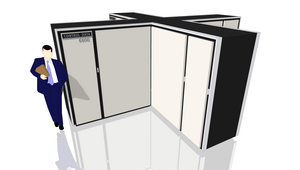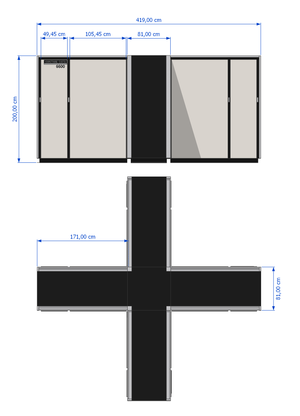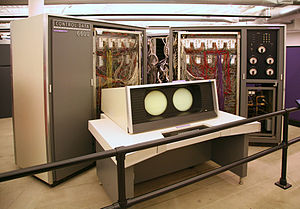
Back سي دي سي 6600 Arabic CDC 6600 German CDC 6600 Spanish CDC 6600 Finnish Control Data 6600 French CDC 6600 HE CDC 6600 Croatian CDC 6600 Hungarian CDC 6600 Italian CDC 6600 Japanese
| CDC 6600 | |
|---|---|
 3D rendering with a figure as scale | |
| Design | |
| Manufacturer | Control Data Corporation |
| Designer | Seymour Cray |
| Release date | September 1964[1] |
| Units sold | 100+ |
| Price | US$2,370,000[2] (equivalent to $23,280,000 in 2023) |
| Casing | |
| Dimensions | Height : 2,000 mm (79 in) Cabinet width: 810 mm (32 in)[3] Cabinet length : 1,710 mm (67 in)[3] Width overall : 4,190 mm (165 in)[3] |
| Weight | about 12,000 lb (6.0 short tons; 5.4 t)[4] |
| Power | 30 kW @ 208 V 400 Hz[5][2] |
| System | |
| Operating system | SCOPE, KRONOS[6] |
| CPU | 60-bit processor @ 10 MHz[7] |
| Memory | Up to 982 kilobytes (131000 x 60 bits)[1] |
| MIPS | 2 MIPS[7] |
| Predecessor | CDC 1604 |
| Successor | CDC 7600 |



The CDC 6600 was the flagship of the 6000 series of mainframe computer systems manufactured by Control Data Corporation.[8][9] Generally considered to be the first successful supercomputer, it outperformed the industry's prior recordholder, the IBM 7030 Stretch, by a factor of three.[10][11] With performance of up to three megaFLOPS,[12][13] the CDC 6600 was the world's fastest computer from 1964 to 1969, when it relinquished that status to its successor, the CDC 7600.[14]
The first CDC 6600s were delivered in 1965 to Livermore and Los Alamos.[15] They quickly became a must-have system in high-end scientific and mathematical computing, with systems being delivered to Courant Institute of Mathematical Sciences, CERN,[16][17] the Lawrence Radiation Laboratory,[18] and many others. At least 100 were delivered in total.[19]
A CDC 6600 is on display at the Computer History Museum in Mountain View, California. The only running CDC 6000 series machine has been restored by Living Computers: Museum + Labs.
- ^ a b Adams Survey 1968
- ^ a b The Computer Directory And Buyer's Guide 1967
- ^ a b c 6000 Series Site Prep, Sep 65
- ^ "Control Data 6600: The Supercomputer Arrives". Dr. Dobb's. Archived from the original on 2017-06-05. Retrieved 2018-10-06.
- ^ CDC 6400 Central Processor Training Manual, Feb 67
- ^ Cyber 70 Product Announcement
- ^ a b Whetstone Benchmark History and Results
- ^ Cayton, Andrew R. L.; Sisson, Richard; Zacher, Chris (2006). The American Midwest: An Interpretive Encyclopedia. Indiana University Press. ISBN 0253003490.
- ^ "CDC 6600 – Historical Interlude: From the Mainframe to the Minicomputer Part 2, IBM and the Seven Dwarfs – They Create Worlds". November 8, 2014.
- ^ "Designed by Seymour Cray, the CDC 6600 was almost three times faster than the next fastest machine of its day, the IBM 7030 Stretch." Making a World of Difference: Engineering Ideas into Reality. National Academy of Engineering. 2014. ISBN 978-0309312653.
- ^ "In 1964 Cray's CDC 6600 replaced Stretch as the fastest computer on Earth." Sofroniou, Andreas (2013). Expert Systems, Knowledge Engineering for Human Replication. Lulu.com. ISBN 978-1291595093.
- ^ Anthony, Sebastian (April 10, 2012). "The History of Supercomputers". ExtremeTech. Retrieved 2015-02-02.
- ^ "CDC 6600". Encyclopædia Britannica. Retrieved 2015-02-02.
- ^ "The 7600 design lasted longer than any other supercomputer design. It had the highest performance of any computer from its introduction in 1969 till the introduction of the Cray 1 in 1976." "CDC 7600". Archived from the original on 2016-05-15. Retrieved 2017-10-15.
- ^ N. Lewis, "Purchasing Power: Rivalry, Dissent, and Computing Strategy in Supercomputer Selection at Los Alamos," in IEEE Annals of the History of Computing, vol. 39 no. 3 (2017): 25-40, 2017 [1]
- ^ "The CDC 6600 arrives at CERN". CERN Timelines.
- ^ Compagnie Lyonnaise de Cinéma (14 Jan 1965). "The Contral Data 6600 computer arrives at CERN, the European Organisation for Nuclear Research". CDS Videos.
- ^ "Bumper Crop". Research Review. Lawrence Berkeley Laboratory. 1981. Archived from the original on 2018-01-18. Retrieved 2017-05-04.
- ^ "Control Data 6600: The Supercomputer Arrives". Archived from the original on 7 July 2019.